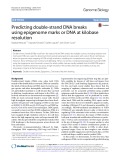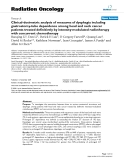
Including radiation
-
Brain metastasis is common in patients with non-small cell lung cancer (NSCLC) and it is associated with poorer prognosis. Several options to control the secondary brain tumors in the context include chemotherapy, whole-brain radiation, stereotactic surgery, surgery. However, chemotherapy is ineffective to those patients because of poor penetration through the blood-brain barrier. Whole-brain radiation therapy used to be a standard option for brain metastases.
 5p
5p  vinatisu
vinatisu
 29-08-2024
29-08-2024
 5
5
 2
2
 Download
Download
-
The overall aim of this study is to determine the most effective way to reduce the radiation dose to the breast during non-breast related CT scans, whilst still maintaining a suitable image quality. This study will attempt to compare the doses and noise of various protocols that can be used for dose reduction, including tube current modulation, bismuth breast shields and manual reduction of tube current.
 111p
111p  runthenight07
runthenight07
 01-03-2023
01-03-2023
 9
9
 2
2
 Download
Download
-
Double-strand breaks (DSBs) result from the attack of both DNA strands by multiple sources, including radiation and chemicals. DSBs can cause the abnormal chromosomal rearrangements associated with cancer. Recent techniques allow the genome-wide mapping of DSBs at high resolution, enabling the comprehensive study of their origins.
 14p
14p  vimichaelfaraday
vimichaelfaraday
 25-03-2022
25-03-2022
 17
17
 1
1
 Download
Download
-
No standard radiotherapy regimens have been established for the treatment of de novo metastatic nasopharyngeal carcinoma (mNPC) with bone-only metastasis. The current study aimed to investigate the efficacy of palliative chemotherapy (PCT) plus locoregional radiotherapy (LRRT) with or without local radiotherapy (RT) for metastatic bone lesions in mNPC.
 9p
9p  vielonmusk
vielonmusk
 21-01-2022
21-01-2022
 12
12
 0
0
 Download
Download
-
Lecture Sensors and analytical devices: Temperature measurement include all of the following: Thermoelectric effect sensors (thermocouples), varying resistance devices, semiconductor devices, radiation thermometers, thermography (thermal imaging), thermal expansion methods, quartz thermometers, fiber – optic temperature sensors,...
 48p
48p  youcanletgo_04
youcanletgo_04
 17-01-2016
17-01-2016
 42
42
 4
4
 Download
Download
-
The siglecs (sialic acid-binding Ig-like lectins) are a distinct subset of the Ig superfamily with adhesion-molecule-like structure. We describe here a novel member of the siglec protein family that shares a similar structure including five Ig-like domains, a transmembrane domain, and a cytoplasmic tail containing two ITIM-signaling motifs. Siglec10 was identified through database mining of an asthmatic eosinophil EST library. Using the Stanford G3 radiation hybrid panel we were able to localize the genomic sequence of siglec-10 within the cluster of genes on chromosome 19q13.
 14p
14p  system191
system191
 01-06-2013
01-06-2013
 43
43
 6
6
 Download
Download
-
Genomic stability is constantly threatened by DNA damage, caused by numerous environmental and intrinsic sources, including radiation, chemi-cals and oncogene expression. Consequently, cells have evolved a sophisti-cated signal transduction network to sense DNA damage and to mount an appropriate DNA damage response.
 10p
10p  viettel02
viettel02
 20-02-2013
20-02-2013
 32
32
 2
2
 Download
Download
-
Tuyển tập các báo cáo nghiên cứu về y học được đăng trên tạp chí y học Radiation Oncology cung cấp cho các bạn kiến thức về ngành y đề tài: " Clinical-dosimetric analysis of measures of dysphagia including gastrostomy-tube dependence among head and neck cancer patients treated definitively by intensity-modulated radiotherapy with concurrent chemotherapy...
 10p
10p  toshiba10
toshiba10
 15-10-2011
15-10-2011
 49
49
 2
2
 Download
Download
-
The skin has many essential functions, including protection, thermoregulation, immune responsiveness, biochemical synthesis, sensory detection, and social and sexual communication. Therapy to correct dysfunction in any of these activities may be delivered topically, systemically, intralesionally, or through ultraviolet radiation.
 32p
32p  vanass
vanass
 01-04-2011
01-04-2011
 80
80
 9
9
 Download
Download
-
The skin has many essential functions, including protection, thermoregulation, immune responsiveness, biochemical synthesis, sensory detection, and social and sexual communication. Therapy to correct dysfunction in any of these activities may be delivered topically, systemically, intralesionally, or through ultraviolet radiation.
 30p
30p  vanass
vanass
 01-04-2011
01-04-2011
 61
61
 8
8
 Download
Download
-
Invasive Disease The treatment of a tumor that has invaded muscle can be separated into control of the primary tumor and, depending on the pathologic findings at surgery, systemic chemotherapy. Radical cystectomy is the standard, although in selected cases a bladder-sparing approach is used; this approach includes complete endoscopic resection; partial cystectomy; or a combination of resection, systemic chemotherapy, and external beam radiation therapy. In some countries, external beam radiation therapy is considered standard.
 5p
5p  konheokonmummim
konheokonmummim
 03-12-2010
03-12-2010
 61
61
 4
4
 Download
Download
-
Table 88-6 Some Novel Medical Treatments for Hepatocellular Carcinoma EGF receptor antibody Erlotinib, Gefitinib Kinase antagonists, Sorafenib Vitamin K IL-2 131 I – ethiodol (Lipiodol) 131 I – Ferritin 90 Yttrium microspheres 166 Holmium Three-dimensional conformal radiation Proton beam high-dose radiotherapy Anti-angiogenesis strategies, Bevacizumab Note: EGF, epidermal growth factor; IL, interleukin. Summary Most Common Modes of Patient Presentation 1.
 5p
5p  konheokonmummim
konheokonmummim
 03-12-2010
03-12-2010
 84
84
 5
5
 Download
Download
-
One approach—so-called neoadjuvant chemotherapy—involves the administration of adjuvant therapy before definitive surgery and radiation therapy. Because the objective response rates of patients with breast cancer to systemic therapy in this setting exceed 75%, many patients will be "downstaged" and may become candidates for breast-conserving therapy. However, overall survival has not been improved using this approach.
 5p
5p  konheokonmummim
konheokonmummim
 03-12-2010
03-12-2010
 78
78
 4
4
 Download
Download
-
Small Cell Lung Cancer A simple two-stage system is used. In this system, limited-stage disease (seen in about 30% of all patients with SCLC) is defined as disease confined to one hemithorax and regional lymph nodes (including mediastinal, contralateral hilar, and usually ipsilateral supraclavicular nodes), while extensive-stage disease (seen in about 70% of patients) is defined as disease exceeding those boundaries. Clinical studies such as physical examination, x-rays, CT and bone scans, and bone marrow examination are used in staging.
 6p
6p  konheokonmummim
konheokonmummim
 03-12-2010
03-12-2010
 85
85
 5
5
 Download
Download
-
Chemoprevention β-Carotene and cis-retinoic acid can lead to the regression of leukoplakia. However, cis-retinoic acid does not reduce the incidence of second primaries Treatment Complications Complications from treatment of head and neck cancer are usually correlated to the extent of surgery and exposure of normal tissue structures to radiation. Currently, the extent of surgery has been limited or completely replaced by chemotherapy and radiation therapy as the primary approach. Acute complications of radiation include mucositis and dysphagia.
 5p
5p  konheokonmummim
konheokonmummim
 03-12-2010
03-12-2010
 87
87
 7
7
 Download
Download
-
Mucositis Irritation and inflammation of the mucous membranes particularly afflicting the oral and anal mucosa, but potentially involving the gastrointestinal tract, may accompany cytotoxic chemotherapy. Mucositis is due to damage to the proliferating cells at the base of the mucosal squamous epithelia or in the intestinal crypts. Topical therapies, including anesthetics and barrier-creating preparations, may provide symptomatic relief in mild cases.
 4p
4p  konheokonmummim
konheokonmummim
 03-12-2010
03-12-2010
 69
69
 4
4
 Download
Download
-
Mitomycin C undergoes reduction of its quinone function to generate a bifunctional DNA alkylating agent. It is a broadly active antineoplastic agent with a number of unpredictable toxicities, including delayed bronchospasm 12–14 h after dosing and a chronic pulmonary fibrosis syndrome more frequent at doses of 50–60 mg/m2. Cardiomyopathy has been described, particularly in a setting of prior radiation therapy. A hemolytic/uremic syndrome carries an ultimate mortality rate of 25–50% and is poorly treated by conventional component support and exchange transfusion.
 5p
5p  konheokonmummim
konheokonmummim
 03-12-2010
03-12-2010
 62
62
 4
4
 Download
Download
-
Principles of Chemotherapy Medical oncology is the subspecialty of internal medicine that cares for and designs treatment approaches to patients with cancer, in conjunction with surgical and radiation oncologists. The core skills of the medical oncologist include the use of drugs that may have a beneficial effect on the natural history of the patient's illness or favorably influence the patient's quality of life. In general, the curability of a tumor is inversely related to tumor volume and directly related to drug dose.
 9p
9p  konheokonmummim
konheokonmummim
 03-12-2010
03-12-2010
 93
93
 5
5
 Download
Download
-
Although radiation can interfere with many cellular processes, many experts feel that a cell must undergo a double-strand DNA break from radiation in order to be killed. The factors that influence tumor cell killing include the D0 of the tumor (the dose required to deliver an average of one lethal hit to all the cells in a population), the Dq of the tumor (the threshold dose—a measure of the cell's ability to repair sublethal damage), hypoxia, tumor mass, growth fraction, and cell cycle time and phase (cells in late G1 and S are more resistant). Rate of clinical response...
 5p
5p  konheokonmummim
konheokonmummim
 03-12-2010
03-12-2010
 55
55
 4
4
 Download
Download
-
Figure 80-1 Induction of p53 by the DNA damage and oncogene checkpoints. In response to noxious stimuli, p53 and mdm2 are phosphorylated by the ataxia telangiectasia mutated (ATM) and related ATR serine/threonine kinases, as well as the immediated downstream checkpoint kinases, Chk1 and Chk2. This causes dissociation of p53 from mdm2, leading to increased p53 protein levels and transcription of genes leading to cell cycle arrest (p21Cip1/Waf1) or apoptosis (e.g., the proapoptotic Bcl-2 family members Noxa and Puma).
 5p
5p  konheokonmummim
konheokonmummim
 03-12-2010
03-12-2010
 75
75
 6
6
 Download
Download
CHỦ ĐỀ BẠN MUỐN TÌM
































